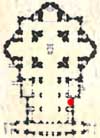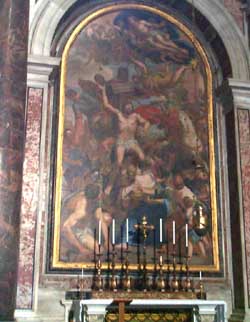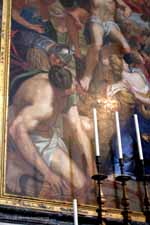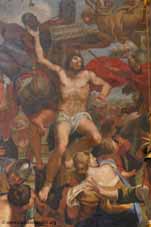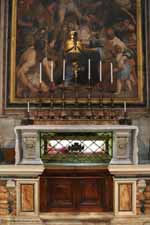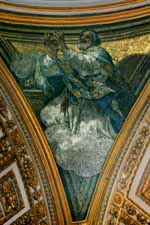| Grottoes
Vatican City Colonnade Saints Floorplan #2 |
| Altars
Monuments The History |
| Related
Sites St. Sebastian Bl. Innocent XI |
From:
'St. Peter's - Guide to Basilica and Square'
The Chapel of St. Sebastian, named after the subject of the mosaic above
the altar, immediately follows. It was completed by Pier Paolo Cristofari
after a drawing by Domenico Zampieri, better known as Domenichino (1581-1641).
Below the altar the body of Bl. Innocent XI (1676-1689) is preserved in
a crystal casket.
In this chapel we also find two modern works. On the right is the statue of Pius XI (1922-1939), the first sovereign of Vatican City State which was created in 1929 as a result of the Lateran Pact. The statue was made by Francesco Nagni (1897-1977) in 1949.
On the left is the
statue of Pius XII (1939-1958), commissioned by the Cardinals he had created,
and made by Francesco Messina in 1964. The Pope is shown blessing the
faithful, clad in papal robes. His gesture also seems to express his desire
to put an end to the scourge of the Second World War, while his expression
seems to reiterate his famous sentence: "Nothing is lost in peace, all
can be lost with war".
From:
'St. Peter's Basilica - A Virtual Tour' by Our
Sunday Visitor
Next comes the St. Sebastian Chapel, over the altar of which is a copy
in mosaic by Cristofari of the fresco by Domenichino, which once decorated
this chapel, but was then transferred in 1730 to the church of Santa Maria
degli Angeli, under the guidance of Zabaglia, a famous head "sampietrino"
and inventor of several "machines and devices" used to carry out complex
operations for the transfer of works of art. The Saint, captain of the
praetorians and martyred under Diocletian, is shown tied to a tree in
the Adonis wood on the Palatine, about to be pierced by arrows. This is
an example of classicist nobility of expression and composition.
In the cupola, the corbels and the lunettes, Pietro da Cortona on the contrary offers us a typical example of Baroque decoration, of which he was a master in Rome. The dynamism and pleasantness of his inventive style appear natural in their easy execution and in their pictorial smoothness, even though they are in effect based on the painter's great skills in perspective and composition.
The cupola shows the apocalyptic scene of the Glory of the Throned Eternal Father near the divine Lamb adored by martyrs carrying the palms of martyrdom. The corbels show Abel who offers the lamb in sacrifice, Isaiah with the saw, instrument of the martyrdom, Ezekiel killed for his faith and Zechariah stoned in the vestibule of the Temple. The lunettes show the Martyrdom of the seven Maccabee brothers and their mother, Mattathias killing the Hebrew Apostate, Daniel in the lion pit, the three boys in the burning furnace, the old Eleazar conducted to his torture, the Hebrew women thrown from the walls for having circumcised their sons.
From:
'Seminarian's Guide'
St. Sebastian died c. 288 in the Diocletian-Maximian persecution.
He was the captain of the famous Praetorian Guard. After being shot with
arrows for confessing Christianity, he was nursed back to health. In a
remarkable act of bravery, however, he later intercepted the Emperor,
denounced him for the persecutions, and was rewarded for his efforts by
being beaten to death on the Emperor's direct orders. Under the altar
lie the remains of Blessed Innocent XI (1676-1689).
'The Altars and
Altarpieces of New St. Peter's' by Louise Rice, ©1997, Cambridge
University Press
When in March 1625 the Congregation of the Fabbrica commissioned Domenichino
to paint an altarpiece in the second chapel on the right of the nave,
the dedication of the chapel had not yet been determined. At that point
the cardinals.. were planning to paint an episode from the life of St.
Peter.
The canons therefore proposed dedicating the second chapel on right in honor of St. Sebastian...and providing it with a major relic, the body of St. Boniface IV. To gain support for their petition, they played on the pope's (Urban VIII) personal attachment to the saint.
Urban VIII may indeed have been more than usually devoted to St. Sebastian. The Barberini family chapel in S. Andrea della Valle, purchased, decorated, and richly endowed by Urban before he became pope, is built over the spot where, according to legend, the body of the saint was retrieved from the sewer into which it had been dumped by his executioners.
Domenichino was awarded the commission for the altarpiece by March 26, 1625. He worked on the painting until his departure for Naples in 1631.
On June 2, 1672, the relics of the martyr saints Innocent, Victor, Candidus and Laureatus were deposited in the altar, which was then dedicated. Domenichino's altarpiece was restored by Giuseppe Montano in 1694. In 1736, it was detached from the wall and transported to the church of S. Maria degli Angeli.
From: 'The Mosaics
of Saint Peter's' by Frank DiFrederico
Domenichino's original picture for this altar was painted in oil on a
stucco ground. He was paid for it from 1625 to 1635. In 1736 the picture
was transferred to S. Maria degli Angeli, Rome, and replaced by a mosaic
executed by Pietro Paolo Crisofari on the basis of a cartoon painted by
Luigi Vanvitelli in 1730.
